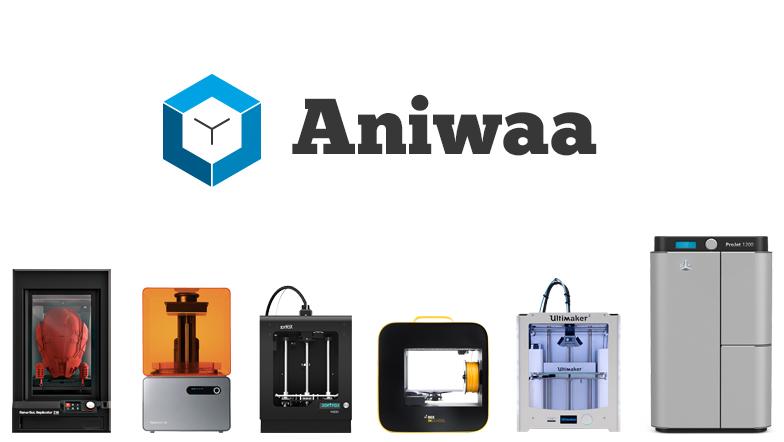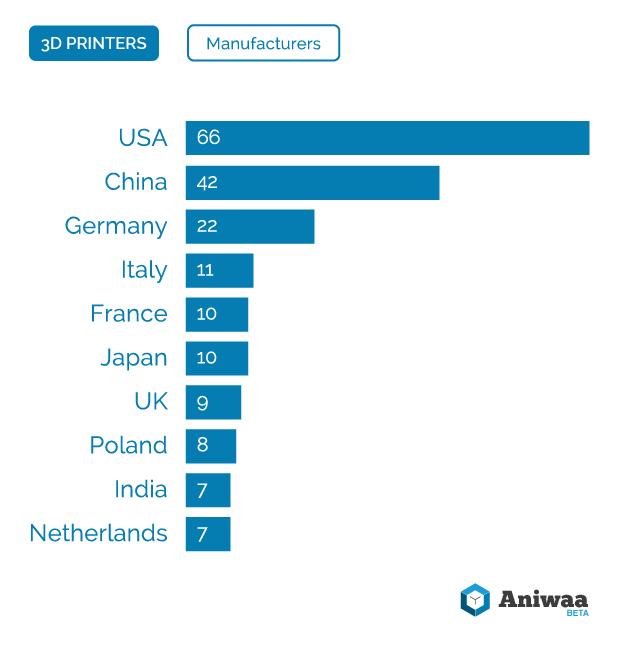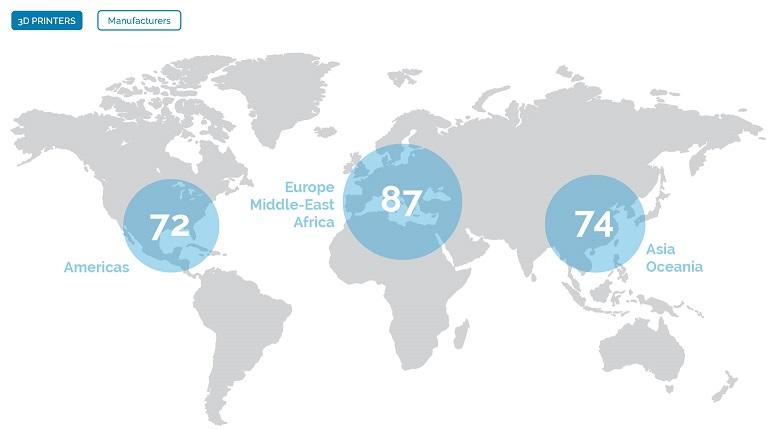Dedicated to the Full Time Facts & Figures of 3D Printing: Aniwaa Releases First 3D Printing Market Watch
 It’s obvious that 3D printing is prevalent in major cities around the world, from New York to Milan, but you may be surprised to find out who is really using what to innovate, and where, and how much they spent overall. While we keep up with all the industry trends and analyses, we found some very interesting facts and surprises in the first edition of the Aniwaa 3D Printing Market Watch, released on yesterday’s global 3D Printing Day, which not only offers a breakdown of more than 900 3D printers by category, technology, and price, but also offers data on global distribution of 3D printers manufacturers, by country and regions.
It’s obvious that 3D printing is prevalent in major cities around the world, from New York to Milan, but you may be surprised to find out who is really using what to innovate, and where, and how much they spent overall. While we keep up with all the industry trends and analyses, we found some very interesting facts and surprises in the first edition of the Aniwaa 3D Printing Market Watch, released on yesterday’s global 3D Printing Day, which not only offers a breakdown of more than 900 3D printers by category, technology, and price, but also offers data on global distribution of 3D printers manufacturers, by country and regions.
“As you may know, Aniwaa is a product-centric 3D printing platform and we’ve built a unique database of 3D printers and 3D scanners. This report provides high-level information about the 3D printing industry, with a focus on products. As always, we strive to be factual, reliable and comprehensive,” Aniwaa co-founder Martin Lansard told 3DPrint.com.
We’ve been following Aniwaa and their dedication to the facts and figures about 3D printing, especially with their recent website update. This data crunching of theirs is no small whim or side job either, as founders Martin Lansard and Pierre-Antoine Arrighi both left promising jobs with large companies last year to pursue what developed into a full-time production of comparative data. With V2, their new site recently launched, they allow those interested in the market to make comparisons between products–currently holding database information on 855 3D printers, 227 3D scanners, and 105 3D sites and software products.
As we all know, the numbers don’t lie, so despite the growing range of products being pushed into the marketplace and the enormous buzz regarding research and development with processes like bioprinting, what we see is that it’s still pretty much business as normal regarding hardware. Close to 60% of users are employing standard extruding 3D printers, with another 21% delving into the more challenging range of resin-based printers. Bioprinting is so slim that it doesn’t even have a percentage number assigned to it. Yet. Powder-bed printing, or metal 3D printing is still low in the numbers–again, for now–as is material jetting.
 While the use of desktop and industrial printers are running neck and neck, also rather startling is the minor usage of kits, along with 3D printing pens, which is surprising considering how often we see these being used by students and artists these days. And when it comes to price, experts have been right all along–those engaging in 3D printing demand affordability, and most aren’t willing to spend over $5K on the technology. Looking at the spread of categories, from $0-5K up to $250K, out of 903 printers, 450 spent the least amount, while some surprising numbers invested in the extremely pricey machines at the highest end.
While the use of desktop and industrial printers are running neck and neck, also rather startling is the minor usage of kits, along with 3D printing pens, which is surprising considering how often we see these being used by students and artists these days. And when it comes to price, experts have been right all along–those engaging in 3D printing demand affordability, and most aren’t willing to spend over $5K on the technology. Looking at the spread of categories, from $0-5K up to $250K, out of 903 printers, 450 spent the least amount, while some surprising numbers invested in the extremely pricey machines at the highest end.
 Globally, looking at continents overall, distribution of printer manufacturers looks extremely balanced, with Europe actually boasting the highest number of 3D printer manufacturers, with 84 brands. It’s certainly no surprise at all to see China’s continued growth either, as they show China 42 3D printer manufacturers, making them second only to the US, with 66 manufacturers currently.
Globally, looking at continents overall, distribution of printer manufacturers looks extremely balanced, with Europe actually boasting the highest number of 3D printer manufacturers, with 84 brands. It’s certainly no surprise at all to see China’s continued growth either, as they show China 42 3D printer manufacturers, making them second only to the US, with 66 manufacturers currently.
There’s plenty going on in the 3D scanning market as well, as innovations continue to erupt there, as well as lower prices and competition in the marketplace. The majority of scanners are still being used at industrial venues, employing structured light–with most staying in the under $10K range (90), although out of 235 scanners, it is rather surprising to see how many are actually in the mid-range, with 45 purchased in the $10-20K range and 56 in the $20-50K range.
With this first report, Aniwaa is not attempting to overtake industry favorites already out there, like the 3D Hubs guides or monthly reports–but rather they hope to complement them. It seems they are doing a good job at this, as we were able to read with interest and definitely experienced a couple of ‘wow’ moments examining the data.
“We are a product-centric 3D printing platform and we’ve built a unique database of 3D printers and 3D scanners,” states the team in their report.
All data collection and product analysis is done specifically by them for accuracy. Facts are collected directly from manufacturers, and they keep the database continuously updated with new information. What are your thoughts on this report? Let us know in the Aniwaa 3D Printing Watch forum on 3DPB.com.
Subscribe to Our Email Newsletter
Stay up-to-date on all the latest news from the 3D printing industry and receive information and offers from third party vendors.
Print Services
Upload your 3D Models and get them printed quickly and efficiently.
You May Also Like
The Dental Additive Manufacturing Market Could Nearly Double by 2033, According to AM Research
According to an AM Research report from 2024, the medical device industry, specifically in dentistry, prosthetics, and audiology, is expected to see significant growth as these segments continue to benefit from...
Heating Up: 3D Systems’ Scott Green Discusses 3D Printing’s Potential in the Data Center Industry
The relentless rise of NVIDIA, the steadily increasing pledges of major private and public investments in national infrastructure projects around the world, and the general cultural obsession with AI have...
AM Research Webinar Explores Continuum’s Sustainable Metal Additive Manufacturing Powders
Metal additive manufacturing (AM) powder supplier Continuum Powders is working to develop solutions that empower industries to reduce waste and optimize their resources. An independent life cycle assessment (LCA) of...
3D Printed Footwear Startup Koobz Lands $7.2M in Seed Round
California-based Koobz is focused on reshoring the U.S. footwear supply chain with advanced manufacturing processes, including 3D printing. The startup just announced that it has added $6 million to its...

































